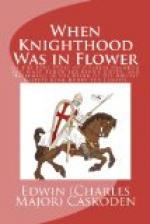One thing about Mr. Major’s work deserves special mention; its shows conscientious mastery of details, a sure evidence of patient study. What it may lack as literature is compensated for in lawful coin of human interest and in general truthfulness to the facts and the atmosphere of the life he depicts. When asked how he arrived at his accurate knowledge of old London—London in the time of Henry VIII—he fetched an old book—Stow’s Survey of London—from his library and said:
“You remember in my novel that Mary goes one night from Bridewell Castle to Billingsgate Ward through strange streets and alleys. Well, that journey I made with Mary, aided by Stow’s Survey, with his map of old London before me.”
It is no contradiction of terms to speak of fiction as authentic. Mere vraisemblance is all very well in works of pure imagination; but a historical romance does not satisfy the reader’s sense of justice unless its setting and background and atmosphere are true to time, place and historical facts. Mr. Major felt the demand of his undertaking and respected it. He collected old books treating of English life and manners in the reign of Henry VIII, preferring to saturate his mind with what writers nearest the time had to say, rather than depend upon recent historians. In this he chose well, for the romancer’s art, different from the historian’s, needs the literary shades and colors of the period it would portray.
Another clever choice on the part of our author was to put the telling of the story in the mouth of his heroine’s contemporary. This, of course, had often been done by romancers before Mr. Major, but he chose well, nevertheless. Fine literary finish was not to be expected of a Master of the Dance early in the sixteenth century; so that Sir Edwin Caskoden, and not Mr. Major, is accepted by the reader as responsible for the book’s narrative, descriptive and dramatic style. This ruse, so to call it, serves a double purpose; it hangs the glamour of distance over the pages, and it puts the reader in direct communication, as it were, with the characters in the book. The narrator is garrulous, and often far from artistic with his scenes and incidents; but it is Caskoden doing all this, not Mr. Charles Major, and we never think of bringing him to task! Undoubtedly it is good art to do just what Mr. Major has done—that is, it is good art to present a picture of life in the terms of the period in which it flourished. It might have been better art to clothe the story in the highest terms of literature; but that would have required a Shakespeare.




